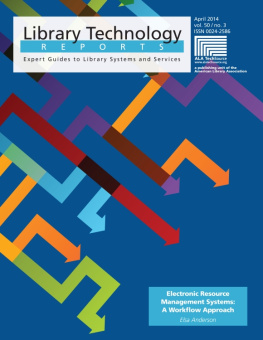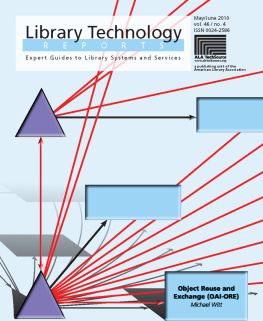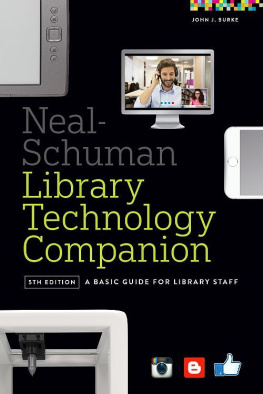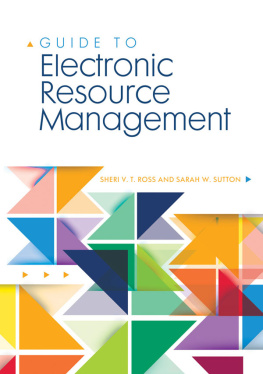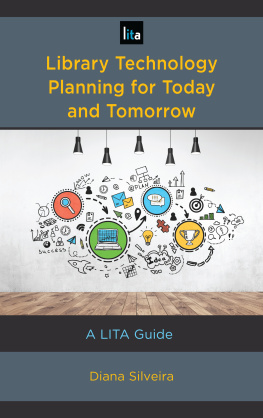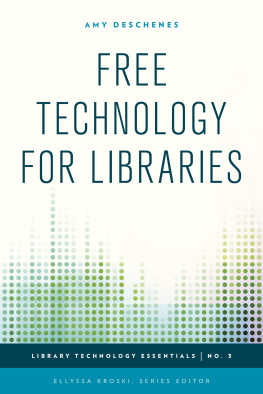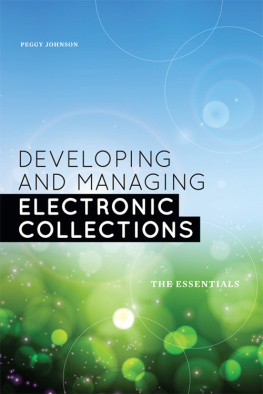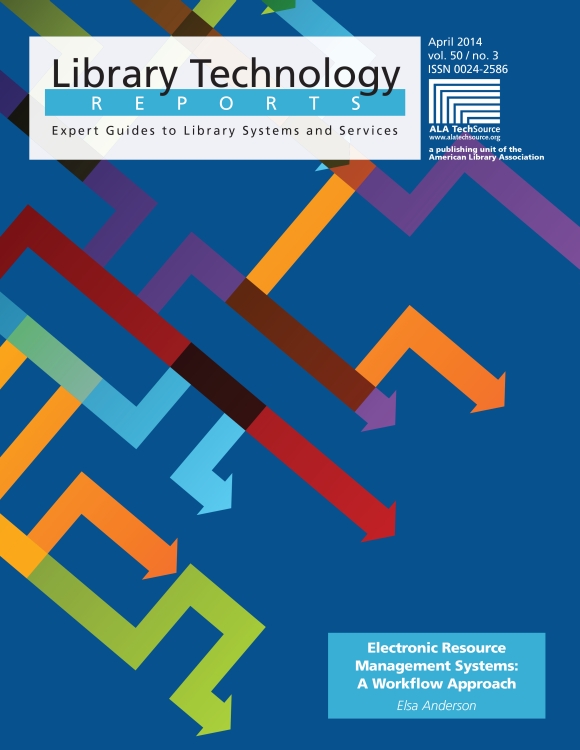
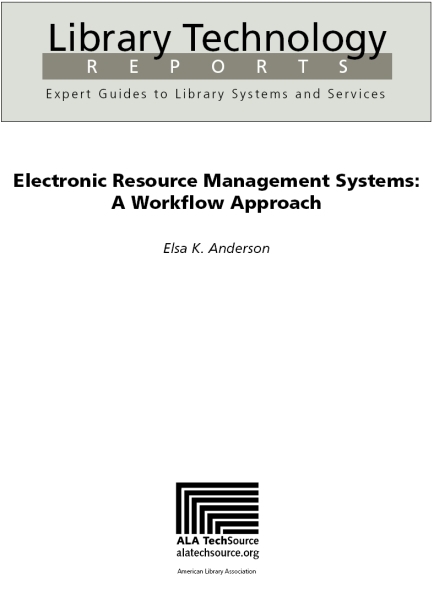
Library Technology Reports
ALA TechSource purchases fund advocacy, awareness, and accreditation programs for library professionals worldwide.
Volume 50, Number 3
Streaming Video Resources for Teaching, Learning, and Research
ISBNs: (print) 978-0-8389-5922-0; (PDF) 978-0-8389-5923-7; (ePub) 978-0-8389-5924-4; (Kindle) 978-0-8389-5925-1.
American Library Association
50 East Huron St.
Chicago, IL 60611-2795 USA
alatechsource.org
800-545-2433, ext. 4299
312-944-6780
312-280-5275 (fax)
Advertising Representative
Patrick Hogan
312-280-3240
Editor
Patrick Hogan
312-280-3240
Copy Editor
Judith Lauber
Production and Design
Tim Clifford, Production Editor
Karen Sheets de Gracia, Manager of Design and Composition
Library Technology Reports (ISSN 0024-2586) is published eight times a year (January, March, April, June, July, September, October, and December) by American Library Association, 50 E. Huron St., Chicago, IL 60611. It is managed by ALA TechSource, a unit of the publishing department of ALA. Periodical postage paid at Chicago, Illinois, and at additional mailing offices. POSTMASTER: Send address changes to Library Technology Reports, 50 E. Huron St., Chicago, IL 60611.
Trademarked names appear in the text of this journal. Rather than identify or insert a trademark symbol at the appearance of each name, the authors and the American Library Association state that the names are used for editorial purposes exclusively, to the ultimate benefit of the owners of the trademarks. There is absolutely no intention of infringement on the rights of the trademark owners.

alatechsource.org
Copyright 2014 Elsa K. Anderson
All Rights Reserved.
About the Author
Elsa K. Anderson is the discovery services manager at the Icahn School of Medicine at Mount Sinai. She is responsible for collections budgeting and management, as well as the electronic resources staff and discovery at the library. Elsa has more than ten years of academic library experience in Vermont and New York City. She received her MLIS from Simmons College in 2005.
Abstract
This issue of Library Technology Reports (vol. 50, no. 3) Electronic Resource Management Systems: A Workflow Approach draws on concepts of the Digital Library Federation report Electronic Resource Management and interviews with staff at eleven libraries. Elsa K. Anderson describes the components of electronic resource management systems and describes product options. Experiences of librarians interviewed suggest the importance of analyzing workflows prior to making any product decisions. The report outlines workflow factors and presents an overview of the marketplace as well as options for homegrown systems.
Get Your Library Technology Reports Online!
Subscribers to ALA TechSources Library Technology Reports can read digital versions, in PDF and HTML formats, through the scholarly content host MetaPress. Subscribers also have access to an archive of past issues. Visit , if you have any questions about or problems with access.
Subscriptions
alatechsource.org/subscribe
Contents
Chapter 1
Abstract
Chapter 1 of Library Technology Reports (vol. 50, no. 3) Electronic Resource Management Systems: A Workflow Approach covers background and provides an overview on electronic resource management, including the DLF-ERMI report, a definition of ERMS, and the methodology employed in writing this report. Electronic resources management is both different and more difficult than print materials management. New software such as ERMS has been developed to help with this complex management process, but this software is only helpful if the process of resource management is rethought from a workflow perspective.
E lectronic resources such as e-journals, e-books, and databases are now a major component of library holdings. Managing these resources is both different from and more complicated than managing traditional print journals because of the large number of titles and quickly changing holdings and environment.
Libraries have always specialized in tracking and communicating information, but the sudden rise of electronic resources required extensive changes over a short period of time. The pace of change means that some libraries have struggled simply to keep up without having an opportunity to analyze long-term impact on services, collections, and workflow. The requirements for managing print were fundamentally different from those for managing the electronic environment of today. As libraries attempted to come to terms with electronic resources, procedures and workflows developed. In many cases, these procedures grew organically from print management and were either insufficient or not optimal, even as collection budgets and workload shifted. Libraries recognized the need for an easier way to track and manage these resources, in some cases developing homegrown databases and systems or requesting additional software from vendors. Library software vendors recognized and responded to this need by adding or developing additional functionality for their software. These new systems go by the name electronic resource management systems or ERMSs, which can refer to either completely new software systems or new functionality added to existing software.
Currently there are many different systems to choose from. Commercial systems are available from almost all library software vendors, and there are multiple open-source options. These systems can be complex stand-alone software, additional modules added into an integrated library system or link resolver, or simply a local Microsoft Access database used to collect statistics. However, no system is perfect, and each one, be it homegrown, commercial, or open-source, has its own complexities and idiosyncrasies. The key factor for electronic resource management (ERM) success is not the software, but the structure and convenience of the library workflow. Analyzing workflow for electronic resources is one of the most important pieces of any electronic resources software implementation. Therefore, it is important for a library interested in an ERMS or workflow reevaluation to think carefully about priorities and to become familiar with the pluses and minuses of each option being considered.
My impression, formed through research and interviews with staff at eleven libraries, is that the ERMS implementation is most successful and workflow is most satisfactory when workflow is considered from the beginning. It is important to not only look at a macro view of the workflow, but also to analyze each step for problems or gaps in communication. Sometimes the result of this analysis might point to an ERMS as the solution, but not always. In general, an ERMS will be helpful if the software can fill gaps in tracking or communication, eliminate a data silo or aggregate all important data together, or replace tedious manual tasks or duplicate systems.
The purpose of this report is to provide some general outlines, best practices, and important points to consider with regard to ERMS implementation. It contains a summary of major ERMS software and some of the pros and cons of the popular options as articulated by librarians who use those systems. Above all, it discusses the importance of workflowthe component pieces of electronic resources managementand ways to break down technical service department processes to examine and improve workflow. This report came out of frustration at having to reinvent the wheel in order to implement an ERMS or think strategically about workflow. My intent is to suggest some questions worth considering and a place to start the process, to discuss the pros and cons of various ERMS solutions, and generally to give an overview of the current situation of the ERM environment and the various factors that impact it while highlighting some of the major resources available for more information.
Next page
